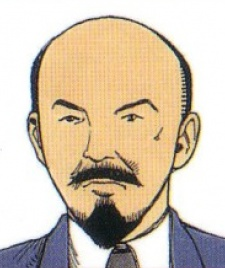
| Original Name (Japanese) | ウラジーミル・レーニン |
|---|---|
| Romaji Name | Urajīmiru Rēnin |
| Nicknames | N/A |
| Series | Odoru! Kremlin Kyuuden |
| Age | 53 (at time of death) |
| Weight | N/A |
| Height | N/A |
| Date of Birth | April 22, 1870 |
| Blood Type | N/A |
Personality
Vladimir Lenin, as portrayed in the anime “Odoru! Kremlin Kyuuden,” is a complex and multifaceted character. He is portrayed as a driven and determined individual with a strong commitment to his political ideologies. Despite his authoritarian tendencies, Lenin is also portrayed as charismatic and influential, able to rally the masses to his cause.
Background
In the context of the anime, Vladimir Lenin’s background is not explicitly explored. However, given his prominent role in the story, it can be inferred that he is a historical figure who played a significant role in the creation of the Soviet Union. His revolutionary activities and leadership are likely to be central to the narrative of the series.
Appearance
The visual representation of Vladimir Lenin in “Odoru! Kremlin Kyuuden” is consistent with his historical portrayal. He is shown with his distinctive bald head, neatly trimmed beard, and penetrating gaze. His attire, likely inspired by his real-life counterpart, consists of a dark suit and tie, conveying an air of authority and seriousness.
Abilities
As a prominent political figure, Vladimir Lenin’s primary abilities center on his strategic thinking, rhetorical skills, and ability to mobilize the masses. In the anime, he is likely to be portrayed as a skilled orator and tactician, capable of outmaneuvering his opponents and consolidating his power.
Origin
The origin of Vladimir Lenin in the context of “Odoru! Kremlin Kyuuden” is firmly rooted in the historical events of the Russian Revolution and the establishment of the Soviet Union. As the founder of the Bolshevik Party and the first leader of the Soviet state, his character is integral to the narrative and serves as a representation of the ideological and political forces that shaped the course of Russian history in the early 20th century.
Vladimir Lenin – FAQ
Here are 6-8 FAQs about Vladimir Lenin from “Odoru! Kremlin Kyuuden”:
Who was Vladimir Lenin?
Vladimir Lenin was the founder of the Communist Party of Russia, the first leader of the Soviet state, and the primary theorist of Leninism, which served as the basis for the ideology of the Soviet government. He led the Bolshevik Revolution of 1917, which overthrew the Romanov dynasty and established the Soviet Union.
What was Lenin’s role in the Russian Revolution?
Lenin was the driving force behind the Bolshevik seizure of power in the Russian Revolution of 1917. He returned to Russia in April 1917 after years of exile and immediately began agitating for the Bolsheviks to take control of the government. His “April Theses” laid out the party’s plan to overthrow the Provisional Government and establish a socialist state. Lenin then played a key role in the planning and execution of the Bolshevik coup in October 1917.
What was Lenin’s vision of the Soviet Union?
Lenin envisioned the Soviet Union as a socialist state led by the working class. He wanted to abolish private property and the capitalist system and give all power to “soviets,” or councils of workers, peasants, and soldiers. Lenin implemented a one-party Bolshevik dictatorship and a command economy in pursuit of this communist vision.
How did Lenin consolidate power after the revolution?
After the Bolsheviks seized power, Lenin moved quickly to consolidate his control. He dissolved the elected Constituent Assembly, banned opposition parties, and crushed any resistance through the newly formed Cheka secret police. Lenin also signed the Treaty of Brest-Litovsk, withdrawing Russia from World War I, and launched a bloody civil war against anti-Bolshevik “White” forces.
What was the New Economic Policy (NEP)?
In 1921, Lenin introduced the New Economic Policy, which allowed for limited private enterprise and the restoration of a market economy, in contrast to the earlier policies of “war communism. The NEP was an attempt to revive the Russian economy, which had been devastated by years of war and revolution. It remained in effect until Stalin’s collectivization campaigns in the late 1920s.
How did Lenin die and what was his legacy?
Lenin suffered a series of strokes beginning in 1922 and died in 1924 at the age of 53. His death led to a power struggle between Stalin and other Bolshevik leaders. Lenin’s embalmed body was placed in a mausoleum in Moscow, where it remains today. Although the Soviet system he created eventually collapsed, Lenin is remembered as the founder of the world’s first socialist state and a towering figure in 20th-century history.


